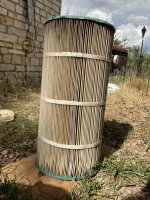I was having a heck of a time with the CH test and vanishing endpoint issue. I finally settled on a procedure that works: Pool water diluted 1:1 with distilled water, 10 ml sample size, and pre-treat with 3 drops of R-0012. I get a nice, permanent color change to blue, and I’m confident in my CH result.
My question is, should I try to treat the metal ions that are apparently present and interfering with the CH test? I suspect iron is the culprit, as I know our well is high in iron. We recently replastered the pool, and although I filled the pool about 2/3 with filtered well water, the final 1/3 or so is unfiltered. The pool folks added 1 gallon of Startup-Tec to the newly filled pool. Should I add another dose of sequestrant or try to otherwise treat the (presumed) high metal content in the water? I do top off the pool with filtered, softened water, so hopefully no additional metals will be added on an ongoing basis.
My question is, should I try to treat the metal ions that are apparently present and interfering with the CH test? I suspect iron is the culprit, as I know our well is high in iron. We recently replastered the pool, and although I filled the pool about 2/3 with filtered well water, the final 1/3 or so is unfiltered. The pool folks added 1 gallon of Startup-Tec to the newly filled pool. Should I add another dose of sequestrant or try to otherwise treat the (presumed) high metal content in the water? I do top off the pool with filtered, softened water, so hopefully no additional metals will be added on an ongoing basis.


